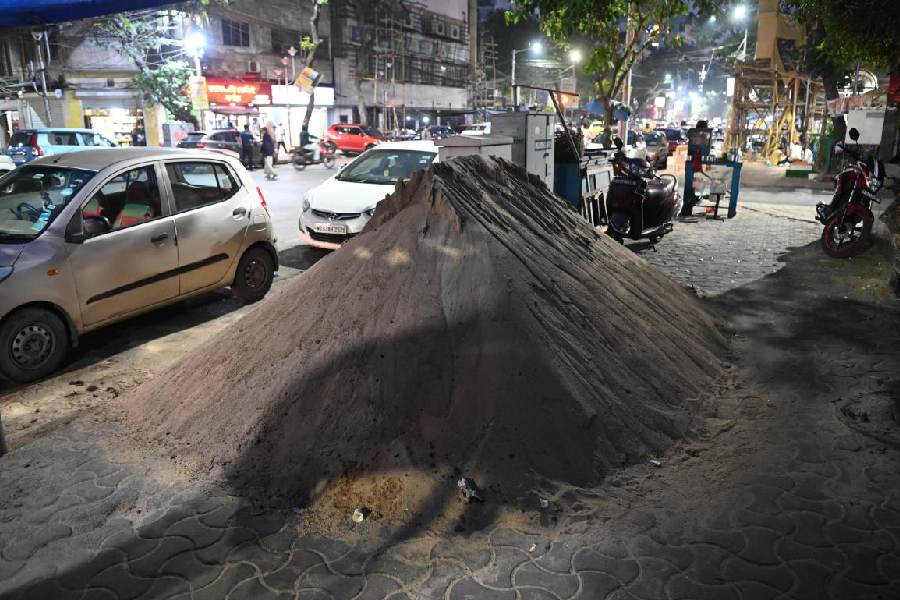The dust rising from construction and demolition sites adds to the air pollution but most such sites are still operating without any cover, which could have prevented the pollutants from spreading.
The state pollution control board, Calcutta Municipal Corporation (CMC) and the state urban development department have issued guidelines for under-construction sites at various times, said officials.
The guidelines say the sites must be covered to avoid mixing of dust particles in the air, all construction materials should be covered and wheels of trucks leaving such a site must be washed so that the dust is cleaned.

An under-construction buildings not properly covered on Creek Row on Monday.
On Monday, Metro found under-construction buildings on Creek Row and Lenin Sarani without covers.
Similar uncovered sites were spotted in Baguiati and Lake Town and on Jessore Road.
A resident of Bhowanipore said a site next to their home where a large building is coming up does not have any cover. “Dust rises and fills the sky,” he said.
Some buildings had covers on one or two sides while the others were left open. In some, the covers had torn from the middle, raising questions about their efficacy.
Road dust as well as dust particles produced at construction and demolition sites are a major contributor to PM2.5 and PM10, said Abhijit Chatterjee, an associate professor of chemical sciences at Bose Institute and an advisor on air quality management to the CMC.
PM2.5 are particulate matters less than 2.5 micron in size, while PM10 are particulate matters less than 10 micron in size. PM2.5 can breach barriers and enter the bloodstream. The particles can then hit any organ, said scientists.
“The dust rising from construction and demolition sites are soil particles, sand particles and particles of cement and others. These have high concentrations of calcium, iron and silicon, all of which are toxic. They are harmful to breathe in,” said Chatterjee.
Kalyan Rudra, chairperson of the state pollution control board, said construction of buildings with built-up areas of more than 20,000sq m (2,15,000sq ft) need environmental clearance from the board.
“The pollution control board monitors such big projects. But the ones that are smaller have to be checked and monitored by the local municipal bodies,” he said.
Rudra said pollutants can get trapped within 200m of the ground during winter. Weak winds during the season slow down the dispersal of the pollutants.
“The pollutants get trapped closer to the humans and other living beings during winter,” he said.
Sources in the CMC said no architect, engineer or owner of an under-construction building has been hauled up this winter for not covering the sites.
“The CMC rarely verifies whether its guidelines are being followed and the construction and demolition sites covered,” said an official at the civic body.
When asked about the CMC’s role, mayor Firhad Hakim told this newspaper on Monday that he would ask the building department to issue a stop-work notice for under-construction buildings where the guidelines are being violated.
“If someone is found flouting the guidelines, they will be served a notice to take corrective measures within a stipulated time. If they still fail to do so, the building department has to issue a stop-work notice till the time measures are implemented,” Hakim said.
Some of the air quality monitoring stations in Calcutta have recorded “very poor” air on certain days this winter.
At 7pm on Monday, the air quality in at least three monitoring stations — in Ballygunge, Fort William and Victoria Memorial — was “poor”. Three of the remaining four stations recorded “moderate” air and there was no data from the seventh.
A report on the state pollution control board’s website showed the concentration of PM2.5 (24-hour average) was 77.67 microgram per cubic metre of air in Calcutta on Monday.
The permissible level, set by the Central Pollution Control Board, is 60 microgram per cubic metre.
The concentration of PM10 (24-hour average) was 144.04 microgram per cubic metre. The permissible level is 100.






